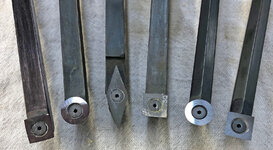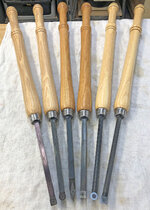Mont
Member
Looking at getting my first set of lathe tools. Most likely carbide as I figure I'll ease into HSS and sharpening at some point down the road. I may take a few day turning class locally come spring that focuses on HSS.
I do plan on using the tools for pen turning primarily. That being said, I'd also like to practice with some other lathe projects every now and then like a bowl here, lidded box there.
So I'm faced with - getting a set of "pen" size tools (or mini/mid... 12-13") and primarily use that for pen turning and other small projects. And then getting the full size tools when I'm ready to tackle the bigger projects. OR, then I thought... why not just get a full sized so I can tackle anything my 12" lathe can handle.
I honestly don't know if there are any downsides to pen turning (or other small projects) with full sized tools or not?
I figured I would ask those with experience here how they approach this?
Any and all experiences, advice, absolutely appreciated!
I do plan on using the tools for pen turning primarily. That being said, I'd also like to practice with some other lathe projects every now and then like a bowl here, lidded box there.
So I'm faced with - getting a set of "pen" size tools (or mini/mid... 12-13") and primarily use that for pen turning and other small projects. And then getting the full size tools when I'm ready to tackle the bigger projects. OR, then I thought... why not just get a full sized so I can tackle anything my 12" lathe can handle.
I honestly don't know if there are any downsides to pen turning (or other small projects) with full sized tools or not?
I figured I would ask those with experience here how they approach this?
Any and all experiences, advice, absolutely appreciated!


